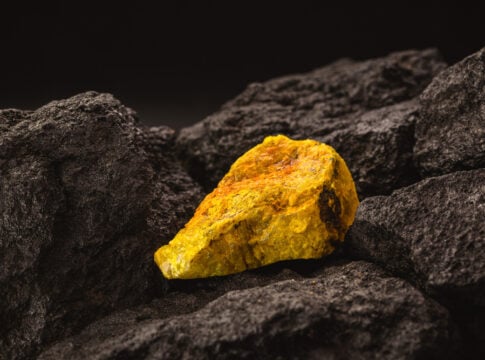Retiring carbon credits can be a powerful tool for individuals and businesses to offset their carbon emissions and contribute to a greener future. By retiring these credits, we can ensure that the emissions reduction achieved is permanent and not double-counted, creating a more transparent and effective carbon market.
This approach not only helps combat climate change but also encourages the development of sustainable practices and technologies.
If you’re into knowing about how the process works, this article will explain everything you need to know about carbon credit retirement. Let’s begin by explaining how these credits work.
Understanding How Carbon Credits Work
Carbon credits are tradable certificates that give entities the right to emit a tonne of CO2 or its equivalent. They are generated by projects that reduce or remove CO2 from the atmosphere like planting trees.
The credits serve as a permit, allowing the holder to neutralize their emissions. In that way, they work like renewable energy certificates (RECs) which are also a market-based instrument that certifies the holder owns a megawatt-hour of electricity from a clean energy source.
Essentially, RECs are a type of carbon credit alongside many others. These credits come in two major categories: compliance and voluntary markets.
In the voluntary carbon markets, carbon credits are also called offsets. Emitters voluntarily bought them to offset their greenhouse gas emissions.
In the compliance markets, businesses’ emissions are ‘capped’. If they go beyond that cap or limit, they’re fined or they can buy carbon credits corresponding to the amount of their excess emissions.
The Lifecycle of a Carbon Credit
Retiring carbon credits involves a series of stages. But let’s focus on the last three crucial steps that ensure the integrity of the credits, the process of trading them, and what it means to retire them.

The verification process is critical for ensuring the accuracy, transparency, and integrity of reported project data. Verifiers have to confirm a project’s compliance with the carbon program’s eligibility criteria. They validate the collection of project monitoring data as per program requirements and verify the accuracy of emissions reduction calculations based on approved methodologies.
After a project has undergone the verification processes, it becomes eligible for registration within the program. In other words, the credits they generate are now available for trading.
Carbon credit trading has become very popular today among individuals and organizations and various carbon exchanges began to emerge. This is happening for a simple reason: Reducing GHG emissions is a global initiative and the carbon market offers great opportunities for entities seeking to cut their emissions.
You can buy or trade carbon credits for retirement purposes through various platforms. There are a couple of online carbon credit marketplaces and spot exchanges to choose from.
Here are the top four carbon exchanges this 2024 that you can consider. You can also try popular marketplaces like the one that Salesforce launched or that of Alcove’s.
Lastly, let’s move toward the end goal of carbon credit trading – retirement.
The Retirement Process Explained
Carbon credit retirement also means their death.
A carbon credit is retired once its benefit has taken place. That means it has been used and the carbon benefit it represents has been claimed by the entity that bought it.
Retiring your carbon credits requires you to ensure that they are removed from the marketplace and labeled as ‘retired’ in any records or registry. The retired credits must serve their emission reduction purpose only once to prevent double counting.
Take note that retirement only occurs once the impact has happened. This means retiring your carbon credits depends on what type of credit you purchase.
If you’ve bought ex-post carbon credits, you can retire them right after your purchase. You can then instantly get the proof of retirement.
For ex-ante and pre-purchase carbon credits, retiring them won’t happen immediately after you bought them. That’s because their impact hasn’t yet occurred and their retirement should be in the future. You should know when the timeline would be from the seller or the marketplace where you purchase the credits. It may take months or even years, depending on the specific project you invest in.
Impact and Benefits of Retiring Carbon Credits
By buying carbon credits, entities help fund efforts that support decarbonization elsewhere. These initiatives often yield positive benefits to the environment and local communities. More importantly, each credit retired helps quantify the actual environmental impact of those projects.
When it comes to the impact of retiring carbon credits on investors, be it individuals or companies, it has two major effects.
First, it preserves the integrity and effectiveness of emission reduction projects. It prevents double counting or reusing of the credits by multiple entities. This further guarantees transparency and accountability in the carbon markets.
In effect, carbon credit retirement instills confidence among companies regarding the impact of their purchases or investments.
Thus, secondly, retiring carbon credits helps build a good reputation and enhance brand value of your company. Take for instance the case of large businesses supporting various carbon reduction projects.
Giant technology companies like Microsoft and Apple have been investing millions in carbon offsets from projects that either reduce or sequester carbon from the atmosphere.
As they do that, they’re not only addressing their emissions but also dealing with their corporate sustainability.
The Role of Carbon Credits in Corporate Sustainability
So, how do carbon credits become the new currency of ESG investing to meet environmental obligations and corporate sustainability?
In the U.S., the coin of the realm is dollars while in the EU, it’s Euro. In the ESG world, it’s the carbon credit. Carbon credits are taking a small space on the ESG goals of businesses.
But as more companies are pledging to reach net zero, these credits are also gaining more momentum in ESG investing to ramp up carbon emission reductions. And slashing emissions has now become a critical element of corporate and environmental responsibility to help fight climate change.
Corporations use carbon credits to reach their net zero, carbon neutrality, or carbon negative goals. As such, research firms estimated that the carbon market will grow as much as 30x more by 2030. If that happens, the market will be as huge as the NASDAQ stock market by the decade’s end.
According to the independent firm Katusa Research, the overall carbon market (compliance and voluntary) could be on equal footing as the oil market.

The burning of fossil fuels emits carbon dioxide, contributing to climate change. Different corporate climate goals mean different things.
Achieving carbon neutrality means balancing emitted and removed CO2. Daily actions like driving emit CO2, but walking or using renewables can reduce it. Carbon credit offsets fund CO2 removal projects.
Carbon negative goes beyond neutrality, removing more CO2 than emitted. For instance, Microsoft aims for carbon negativity by 2030, promising to remove all emissions since its founding. H&M and Ikea also strive for “climate positive,” akin to carbon negativity efforts. Their strategies involve sustainability investments and reduced emissions.
Best Practices in Carbon Credit Retirement
Now, that you know how carbon credits work, the importance of retiring them, and the processes involved, there’s one more thing left to keep in mind. What are the best practices to follow when retiring carbon credits?
We summarize them in two essential points: selecting the right carbon credit projects and transparent reporting of the retirement.
As mentioned earlier, there are plenty of projects generating carbon credits. There are 170+ of them as per the Ecosystem Marketplace report.

So, you must choose the ones that suit your purpose very well. If you’re into nature-based initiatives, you may pick from the different forestry and land use projects, i.e. REDD+. But if you’re operating in the power sector, you may want to go for renewable energy such as supporting solar or wind projects.
Regardless of your choice, be sure to be informed of the existing standards and methodologies for that project. This is crucial so that your carbon credit investment would count by actually reducing emissions. That entails being transparent in reporting your retirement.
Transparency is one of the biggest concerns plaguing the carbon market right now. Questions were raised as to the effectiveness of carbon projects in delivering their emission reduction promises. This caused a rapid decline in voluntary carbon credit prices, particularly the nature-based offsets.
Yet, current and future innovations in carbon credit markets show that they are here to stay and will continue to play a significant role in curbing GHG emissions.
The Future of Carbon Credits
Recent innovations such as the launch of insurance products that protect carbon credits indicate that the market is heading in the right direction. Application integration like the case between Alcove and Shopify is another important market development that tackles transparency in credit retirement.
The use of blockchain technology is also considered a solution to make carbon credit retirement easier to track. Add to this the big players entering the market to further address transparency in tracking the lifecycle of each credit. For example, the NASDAQ exchange launched an innovative technology to revolutionize the industry.
Nasdaq’s new approach uses smart contracts for secure transactions and promises to bring much-needed standardization to attract investors.
Moreover, announcements by countries to integrate carbon markets into national registries also suggest that trading and retiring carbon credits would become the standard in curbing emissions and fighting the climate crisis.
The post Retiring Carbon Credits: Everything You Need To Know appeared first on Carbon Credits.
Carbon Footprint
U.S. Uranium Production Set to Rise as Anfield Energy Gains Velvet-Wood Approval
The U.S. depends heavily on imported uranium to power its nuclear reactors, using about 50 million pounds each year while producing less than 1% at home. Boosting domestic uranium production is crucial for energy security and reducing reliance on foreign sources. In this context, Anfield Energy Inc. (NASDAQ: AEC; TSXV: AEC) is making progress with its Velvet-Wood uranium project in San Juan County, Utah.
The Utah Department of Oil, Gas, and Mining recently approved the project for construction. This allows Anfield to move quickly toward production.
Velvet-Wood Gains Green Light for Rapid Development
In May, Anfield Energy Inc. announced that the U.S. Department of the Interior approved its Velvet-Wood uranium project in San Juan County, Utah.
This project was the first mining initiative approved under a new fast-track permitting process by the U.S. Department of the Interior. This process, introduced after President Trump’s energy emergency declaration in January 2025, lets energy projects complete environmental reviews in just 14 days.
By selecting Velvet-Wood, federal agencies highlighted its importance for the domestic uranium and vanadium supply.
Notably, Secretary of the Interior Doug Burgum said the Bureau of Land Management ensures safe and responsible extraction while protecting the environment.
With federal and state approvals in hand, Anfield plans to start mobilization immediately. The company expects to break ground within 30 days. They will:
- reopen the mine portal
- dewater the site
- build surface facilities
- develop a new mine incline.
These steps aim to bring Velvet-Wood into production quickly while keeping safety and environmental standards high.
Anfield Boots U.S. Energy Security with Domestic Production
Anfield acquired Velvet-Wood in 2015. The mine previously produced around 4 million pounds of uranium and 5 million pounds of vanadium from 1979 to 1984.
- A preliminary economic assessment shows 4.6 million pounds of uranium at a grade of 0.29% eU3O8, plus additional inferred resources.
CEO Corey Dias said the approvals clear the way for building the mine and starting production. The company also plans to increase its reclamation bond with the Bureau of Land Management to meet federal land restoration rules.
Anfield’s project helps the U.S. reduce dependence on foreign minerals. The country imports uranium from Russia, Kazakhstan, and Uzbekistan. Vanadium supply mainly comes from China, Russia, South Africa, and Brazil.
By producing uranium and vanadium domestically, Anfield enhances energy security and supports industries such as nuclear power, aerospace, and defense.
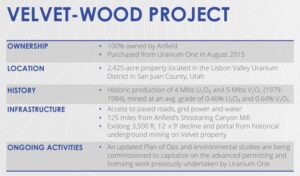
Uranium and Vanadium: Key Strategic Materials
Uranium powers nuclear reactors, fuels U.S. Navy submarines, and helps produce medical isotopes. It is also used in tritium production for national defense. Vanadium strengthens steel and titanium alloys used in both commercial and military aircraft. Together, these minerals are vital for energy, defense, and industrial security.
EIA’s Domestic Uranium Production Report Second-Quarter 2025 highlights that in Q2 2025, the U.S. produced 437,238 pounds of uranium concentrate (U3O8), up 41% from the first quarter’s 310,533 pounds.
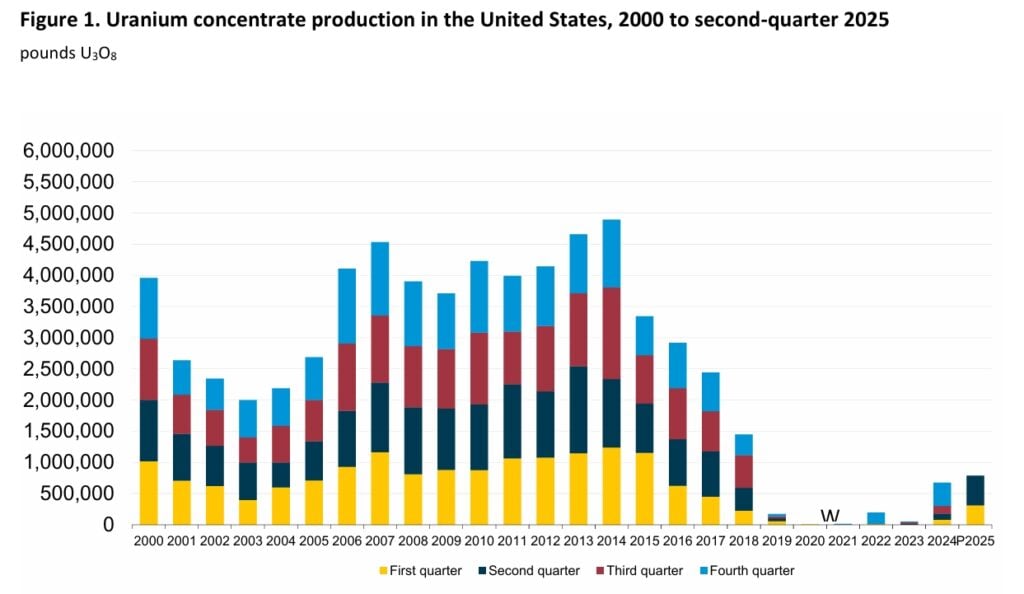
Production came from the following mines:

Underground Mining Keeps Environmental Impact Low
Velvet-Wood will focus on underground mining. The company will use existing mine workings and develop new mineral areas. This approach keeps surface disturbance to just three acres and makes use of the old Velvet mine site.
Anfield also owns the Shootaring Canyon mill, one of only three licensed uranium mills in the U.S. Restarting this mill will allow the company to convert uranium ore into concentrate, reduce reliance on imports, and support domestic nuclear fuel production.
Economic and Strategic Benefits
Anfield combines strong assets with efficient operations. Its hub-and-spoke model links mining sites with processing mills, maximizing the value of Velvet-Wood’s resources. With measured resources, a licensed mill, and fast government approvals, the company is ready to meet growing demand for uranium and vanadium.
The project also brings jobs to Utah and supports local communities. Restarting the Shootaring Canyon mill adds processing capacity, lowers costs, and improves efficiency.
Moving Toward a Sustainable Energy Future
Anfield focuses on sustainable growth. Its operations balance environmental responsibility with energy and defense needs. By producing domestic uranium and vanadium, the company supports a carbon-free energy future while reducing reliance on imports.
Velvet-Wood shows how companies and supportive policies can address energy and security challenges. By using old mining assets and modern techniques, Anfield aims to become a leading U.S. uranium producer. It’s fast move from permitting to production sets an example for other critical mineral projects.
The post U.S. Uranium Production Set to Rise as Anfield Energy Gains Velvet-Wood Approval appeared first on Carbon Credits.
Carbon Footprint
Countdown to CSRD: Your 12-month plan for compliance and competitiveness
2025 marks the decisive year for companies to prepare for CSRD compliance. By next year, thousands of businesses across Europe, large multinationals and SMEs alike, will need to publish detailed sustainability disclosures aligned with ESRS standards. The countdown has officially begun, and with only one reporting cycle left to strategise, getting started now is a must.
![]()
Carbon Footprint
Pentagon’s $1B Mineral Stockpile Boosts U.S. Independence from China
The Financial Times reported that the Pentagon plans to spend up to $1 billion on critical minerals. This move aims to cut U.S. reliance on China for essential metals in defense, clean energy, and advanced tech. Led by the Defense Logistics Agency (DLA), this program is the largest U.S. strategic mineral acquisition since the Cold War.
Significantly, the Pentagon’s plan is part of Trump’s broader “One Big Beautiful Bill Act” (OBBA) to enhance domestic and allied resources. Under OBBA, the DLA will use a $7.5 billion allocation to:
-
Expand the U.S. stockpile by 2027 ($2 billion)
-
Invest in mineral and processing supply chains ($5 billion)
-
Launch a Pentagon credit program to support private mining and refining projects ($500 million)
Washington’s Strategic Push: From Market Reliance to State Control
China’s control over global mineral supply chains has raised national security concerns. The country refines 80–90% of rare earths and dominates other key metals, such as cobalt and nickel.
Recent Chinese export limits on rare earths have raised concerns in the U.S. Washington views these limits as an effort to weaponize mineral exports. The Pentagon’s stockpiling shows a move from market-driven sourcing to state-led resource security.
Trump Targets China with 100% Tariffs
As per the latest news, President Trump has confirmed plans to impose 100% tariffs on all Chinese imports starting on November 1. He labeled China’s export limits a “hostile act.” He noted the timeline might change, saying, “Right now it is. Let’s see what happens.”
On Truth Social, Trump accused Beijing of manipulating supply chains and warned of “100% tariffs… over and above any tariff they are currently paying.”
This tariff announcement follows China’s decision to limit rare earth exports. These actions link industrial policy more closely to national security.
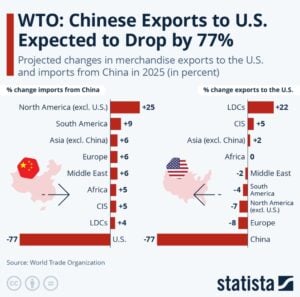
Pentagon Boosts Stockpile with High-Value Minerals
According to the Financial Times, the Pentagon’s buying spree targets four key minerals vital for defense and clean energy:
-
Cobalt – Up to $500 million. Used in batteries, superalloys, and medical implants.
-
Antimony – About $245 million, partly sourced from U.S. Antimony Corp. Key for flame retardants, batteries, and defense components.
-
Tantalum – Around $100 million. Essential for missile systems and aerospace parts.
-
Scandium – A combined $45 million, reportedly from Rio Tinto and APL Engineered Materials. Used in aerospace alloys and electronics.
These purchases will expand the U.S. national stockpile, which already holds $1.3 billion in metals. The new acquisitions focus on materials critical for weapons production, energy systems, and high-tech manufacturing.
A defense official told the FT that several Pentagon offices are now “flush with cash” for mineral procurement. The government is also exploring offshore mineral resources in the Pacific Ocean, rich in nickel, cobalt, copper, and manganese.
Alaska’s Ambler Road Project Approval
President Trump approved the long-contested Ambler Road Project in Alaska. This 211-mile corridor will connect the Dalton Highway to vast mineral deposits in the northwest.
This decision reverses a Biden-era block and is seen as a vital step toward U.S. resource independence. It opens access to copper, zinc, and rare earth elements essential for clean energy and defense manufacturing.
Mineral Stockpiling: Shielding the Nation from Supply Shocks
The U.S. imports over 80% of its critical minerals and relies heavily on foreign refining, according to the U.S. Geological Survey (USGS). This dependence exposes the country to significant supply risks, especially amid rising geopolitical tensions.
The International Energy Agency (IEA) estimates that China controls 90% of rare earth refining and significant percentages of nickel and cobalt refining. Such dominance highlights the risk of relying on a single country for critical inputs.
Thus, to tackle these challenges, the U.S. is building a stockpile of critical minerals. This will reduce supply risks, maintain production of weapons and advanced technologies, and support domestic mining investment.
In short, this stockpile acts as strategic insurance, safeguarding industrial capabilities and boosting national security.
The U.S. aligns with a global trend in mineral stockpiling. The EU requires reserves under its Critical Raw Materials Act. India launched a National Mineral Security Strategy in 2025, while Japan maintains a months-long reserve of rare earths.
Minerals with Net Import Reliance on China
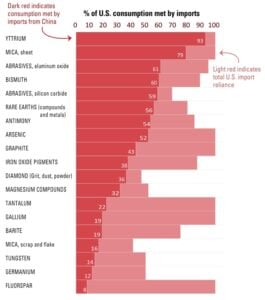
Market Impact and Industry Response
The Pentagon’s stockpiling effort has caught attention in mining and rare earth stocks. Companies like U.S. Antimony and MP Materials are gaining interest as Washington increases mineral procurement.
For example, the DLA’s plan for 3,000 tonnes of antimony—about one-eighth of U.S. annual demand—may stabilize the market for this volatile metal. Analysts expect similar effects for other targeted minerals as demand becomes clearer.
In conclusion, the Pentagon’s $1 billion mineral stockpile plan marks a clear shift. The U.S. government is no longer waiting for markets to secure resources. Instead, it is actively building reserves, funding domestic projects, and aligning economic policy with defense needs.
As competition for minerals increases, the Pentagon’s stockpiling is a defensive strategy and a clear signal. It shows that the next big race among global powers will be for critical minerals. These are vital for future technologies, not oil.
The post Pentagon’s $1B Mineral Stockpile Boosts U.S. Independence from China appeared first on Carbon Credits.
-
Climate Change2 years ago
Spanish-language misinformation on renewable energy spreads online, report shows
-
Climate Change2 months ago
Guest post: Why China is still building new coal – and when it might stop
-
Climate Change Videos2 years ago
The toxic gas flares fuelling Nigeria’s climate change – BBC News
-

 Greenhouse Gases1 year ago
Greenhouse Gases1 year ago嘉宾来稿:满足中国增长的用电需求 光伏加储能“比新建煤电更实惠”
-
Greenhouse Gases2 months ago
Guest post: Why China is still building new coal – and when it might stop
-

 Climate Change1 year ago
Climate Change1 year ago嘉宾来稿:满足中国增长的用电需求 光伏加储能“比新建煤电更实惠”
-

 Carbon Footprint2 years ago
Carbon Footprint2 years agoUS SEC’s Climate Disclosure Rules Spur Renewed Interest in Carbon Credits
-
Renewable Energy3 months ago
US Grid Strain, Possible Allete Sale


